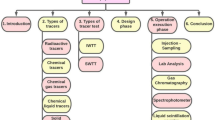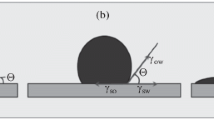Abstract
This chapter describes the use of tracers in oil and gas reservoir exploration and evaluation. The tracers may be radioactive atoms or molecules that are detected by nuclear measuring techniques, naturally occurring stable isotopic ratios detected by electromagnetic isotope separation, or chemical tracers that may be measured by more or less conventional chemical techniques, e.g. gas chromatography. The topics selected for a closer description include:
-
(1)
tracers during drilling and completion of a well (mud infiltration studies, study of the “near wellbore” chemical reactions, control of mud circulation, measurement of injectivity profiles, location of cementing level, detection of casing leaks, selective acidizing and treatment of fractures);
-
(2)
tracers in reservoir evaluation (well-to-well flow studies for water and gas flooding);
-
(3)
tracers for EOR-chemicals (the study of surfactant and polymer behaviour under relevant reservoir conditions);
-
(4)
tracers for the determination of residual oil saturation (partitioning tracers in single well or in well-to-well experiments).
Access this chapter
Tax calculation will be finalised at checkout
Purchases are for personal use only
Preview
Unable to display preview. Download preview PDF.
Similar content being viewed by others
References
Abbaszaden-Dehghani, M. and Brigham, W.E. (1984). Analysis of well-to-well flow to determine reservoir layering. J. Petroleum Technol. (Oct.), 1752–1762.
Abda, M.K., Chung, H.S., Phelps, C.H. and Klaric, T.M. (1984). Field experience with floodwater diversion by complexed biopolymers. Paper no. SPE/DOE 12642.
Beier, R.A. and Sheely, C.Q. (1988). Tracer survey to identify channels for remedial work prior to CO2 injection at MCA unit, New Mexico. Paper no. SPE/DOE 17371.
Bjørnstad, T. et al. (1989). On the use of tracers in mud filtrate and completion fluid invasion studies. To be published as IFE research report.
Bowman, R.S. (1984). Evaluation of some new tracers for soil water studies. Soil Sci. Soc. Am. J. 48, 987.
Buckley, S.E. (1940). Method of locating detectable cement in a borehole US Patent Number 2.220.205.
Charlisle, T. and Kapoor, S. (1982). Development of a rapid and accurate method for determining partition coefficients of chemical tracers between oils and brines. Paper no. DOE/BC/10100–4.
Charyulu, K.S. and Devrajan, N.R. (1977). Role of radioisotopes in oil well investigations. Proceedings National Symposium on Isotopes Applications in Industry. Trombay, Bombay. 1977, p. 102.
Chemicals in the Oil Industry. Proceedings from a symposium organised by the Royal Society of Chemical Industry, Division North West Region, Owens Park, University of Manchester, March 1985.
Chyi-Gang Huang, Green, D.W. and Willhite, G.P. (1984). An experimental study of the in-situ gelation of chromium (+ 3)-polyamide polymer in porous media. Paper no. SPE/DOE 12638.
Clayton, C.G. (1967). A survey of the application of radiation techniques in oil and mineral boreholes. Paper no. AERE-R 5368.
Cooke, C.E., Jr. (1971). Method of determining residual oil saturation in reservoirs. US Patent Number 3.590.923.
Dahl, J.B. (1987). Tracer techniques in near bore-hole chemistry. In Hagebø, E. and Salbu, B. (eds.), “Aspects of Nuclear Science” (in Honour of Prof. A.C. Pappas), p. 142. Norwegian University Press.
Davis, S.N. et al. (1980). Ground water tracers—a short review. Groundwater 18, 14.
Deans, H.A. (1969). Method of determining fluid saturation in reservoirs. US Patent Number 3.623.842.
Deans, H.A. (1976). Method of determining the relation between fractional flow and saturation of oil. US Patent Number 3.990.298.
Deans, H.A., Majores, S. and Heemstra, R.J. (1980). Single well chemical tracer test simulation handbook: “Improved accuracy and interpretation for residual oil saturation measurement. DOE/BC/20006–14. US Department of Energy.
Dietz, R.N. and Senum, G.I. Capabilities, needs and applications of gaseous tracers. Presented at the Atmospheric Tracer Workshop, Santa Fe, May 1984, pp. 123–174. Paper no. LA-10301-C.
D’Hooge, Sheely, Williams, C.G. and Williams, B.J. (1981). Interwell tracers—an effective reservoir evaluation tool. West Sumatra field results. J. Petroleum Technol. 33, 779.
Dovan, H.T. and Hutchins, R.D. (1984) Development of a new aluminium-polymer gel system for permeability adjustment. Paper no. SPE/DOE 12641.
Evans, G.V., Parsons, T.V. and Wallace, M.R.G. (1980). Nuclear grout monitoring on offshore platforms. The 12th Annual Offshore Technology Conference, Houston, Texas, May, 1980, paper no. OTC-3791.
Flagg, A.H., Myers, J.P., Campell, J.L.P., Terry, J.M. and Mardock, E.S. (1955). Radioactive tracers in oil production problems. J. Petroleum Technol. 7, 1.
Ford, W.O. Jr. (1962). How new injectivity profiling method works. World Oil 1 August 43.
Garder, K. and Hundere, I.A. (1988). SPOR-OPT tracer methods for reservoir studies. Institute for Energy Technology, paper no. IFE/KR/F-88/098.
Garder, K. and Michelsen, O.B. (1988). SPOR-OPT tracer studies for improved reservoir description. Institute for Energy Technology, paper no. IFE/KR/F-88/079.
Gore, G.L. (1963). Relative injectivity profiles of irregular size holes. J. Petroleum Technol. 15, 922.
Gore, G.L. and Terry, L.L. (1956). Radioactive tracer techniques. J. Petroleum Technol. 8, 12.
Hill, A.D. and Solares, J.R. (1985). Improved analysis methods for radioactive tracer injection logging. J. Petroleum Technol. 37, 511.
Hubbard, S., Roberts, L.J. and Sorbie, K.S. (1986). Experimental and theoretical investigation of time-setting polymer gels in porous media. Paper no. SPE/DOE 14959.
Janota-Bzowski, J. (1985). Identification of air pollution sources by making use of tracers. Environ. Prof. Eng. 11(2) 27.
Johansen, T., Antonsen, B. and Hidle, S. (1988). Tracer testing for improved reservoir description. SPOR Seminar, Norwegian Petroleum Directorate, Stavanger.
Johansen, T., Antonsen, B. and Hidle, S. (1989). A theory of multicomponent chromatography in two phase flow. Fifth European Symposium on Improved Oil Recovery, Budapest, April 1989.
Kelldorf, W.F.N. (1970). Radioactive tracer surveying—a comprehensive report. J. Petroleum Technol. 22, 661.
Keller, E. (1974). Dual temperature tracer method for determining fluid saturation in petroleum reservoirs. US Patent Number 3.847.548.
Kerrin, S.L. (1981). Perfluorocarbons as hydrological tracers. Paper no. NSF/CPE-81015.
Knaepen, W.A.I., Tijssen, R. and van der Bergen, E.A. (1988). Experimental aspects of the partitioning tracer test for residual oil saturation determination using FIA-based laboratory equipment. SPE European Petroleum Conference, London, October 1988, paper no. SPE 18387.
Lake, L.W. (1988). Enhanced Oil Recovery Manual. Department of Petroleum Engineering, The University of Texas at Austin.
Ledwell, J.R., Watson, A.J. and Brocccher, W.S. (1986). A deliberate tracer experiment in Santa Monica basin. Nature 323, 322–326.
Lopus, T.A., Seifert, D.J. and Schein, G.W. (1987). Production improvement through identification of conductive natural fractures utilizing multiple radioactive isotope tochnology. Paper no. SPE-16192.
Lovelock, J.E. and Ferber, G.J. (1982). Exotic tracers for atmospheric studies. Atmos. Environ. 6, 1467.
McIntyre, F.J. and Polkowski, G. (1985). Radioactive tracer application to monitoring solvent spreading in the Rainbow Keg River B pool vertical hydrocarbon mischible flood. Paper no. SPE 14440.
Michelsen, O.B., Garder, K. and Bjørnstad, T. (1987). Application of radioactive tracers for improved oil recovery. Radiotracer evaluation—literature survey. Paper no. IFE/KR/F-87/167.
Millar, R.H.G. and Buckles, R.S. (1975). Tritiated water as a drilling mud tracer in Beaufort exploration wells. J. Can. Petroleum Technol. 14, 42.
Omoregie, Z.S. et al. (1987). Monitoring the Mitsue hydrocarbon mischible flood program design. Implementation and preliminary results. The 38th Annual Technical Meeting of the Petroleum Society of CIM, Calgary 1987, paper no. 87-38-06.
Paap, HJ., Arnold, D.M. and Peelman, H.E. (1977). Behind casing water flow detection using continuous oxygen activation. US Patent Number 4.032.780.
Pearce, R.M. (1977). Evaluation of fracture treatment using tracer and temperature survey. Paper no. SPE 7910.
Phelps, G.D., Stewart, G. and Peden, J.M. (1984). The analysis of the invaded zone characteristics and their influence on wireline log and well-test interpretation. Paper no. SPE 13287.
Pope, G.A. and Sepehrnoori, K. (1988). Field tracer studies using a compositional simulator. Fifth Annual Report, Center for Enhanced Oil and Gas Recovery Research, University of Texas.
Prud’homme, R.K. and Uhl, J.T. (1984). Kinetics of polymer/metalion gelation. Paper no. SPE/DOE 12640.
Richardson, E.A. (1986). Determining residual oil saturation by injecting CO2 and base generating reactant. US Patent Number 4.617.994.
Richardson, E.A. (1987). Determining residual oil saturation by injecting salts of carbonic and halocarboxylic acids. US Patent Number 4.646.832.
Sheely, C.G. (1979). Single well surfactant test to evaluate surfactant floods using multi tracer method. US Patent Number 4.168. 746.
Sheely, C.Q., Jr. and Baldwin, D.E., Jr. (1978). Single well tracer method to evaluate enhanced recovery. US Patent Number 4.099.565.
Smith, P.J. and Brown, C.E. (1984). The interpretation of tracer test response from heterogeneous reservoirs. Paper no. SPE 13262.
Søhail Aslam and Willhite, G.P. (1984). Viscosimetric measurement of chromium (III)-polyacrylamide gels by Weissenberg rheogoniometer. Paper no. SPE/DOE 12639.
Teichman, C.F. (1944). Method of determining the porosity and location of permeable formations in oil wells. US Patent Number 2.358.945.
Tinker, G.E. (1973). Gas injection with radioactive tracer to determine reservoir continuity—East Coalings field, California. J. Petroleum Technol. (Nov.), 1251–1254.
Tømich et al. (1973). Single well tracer method to measure residual oil saturation. J. Petroleum Technol. (Feb.), 211–218.
Trantham, J.C., Threlkeld, C.B. and Patterson, H.L., Jr. (1980). Reservoir description for a surfactant/polymer pilot in a fractured, oil-wet reservoir. North Burbank Unit Tract 97. J. Petroleum Technol. (Sept.) 1647.
Wagner, O.R., Baker, L.E. and Scott, G.R. (1974). The design and implementation of multiple tracer program for multifluid, multiwell injection projects. Paper no. SPE 5125.
Walker, T., Sherwood, J., Sumner, C.R. and Marshall, R. (1964). The fluid travel log. J. Petroleum Technol. 16, 851.
Watson, A.J. and Ledwell, J.R. (1988). Purposefully released tracers. Tracers in the Ocean, The Royal Society, London,.
Wiley, R. and Cocanower, R.D. (1975). A quantitative technique for determining injectivity profiles using radioactive tracers. Paper no. SPE 5513.
Williams, R.L. and McCarthy, J.T. (1987). Using multiple radioactive tracers to optimize stimulation designs. Paper no. SPE 16383.
Author information
Authors and Affiliations
Editor information
Rights and permissions
Copyright information
© 1990 Norwegian Institute of Technology
About this paper
Cite this paper
Bjørnstad, T., Garder, K., Hundere, I., Michelsen, O.B. (1990). Tracer Tests in Oil Appraisal and Reservoir Evaluation: State of the Art. In: Buller, A.T., Berg, E., Hjelmeland, O., Kleppe, J., Torsæter, O., Aasen, J.O. (eds) North Sea Oil and Gas Reservoirs—II. Springer, Dordrecht. https://doi.org/10.1007/978-94-009-0791-1_22
Download citation
DOI: https://doi.org/10.1007/978-94-009-0791-1_22
Publisher Name: Springer, Dordrecht
Print ISBN: 978-94-010-6843-7
Online ISBN: 978-94-009-0791-1
eBook Packages: Springer Book Archive




